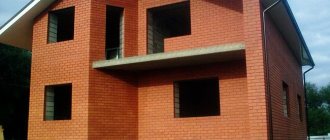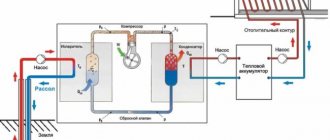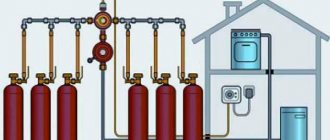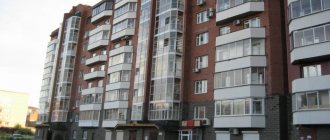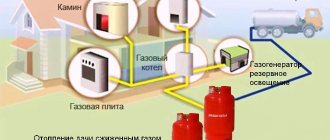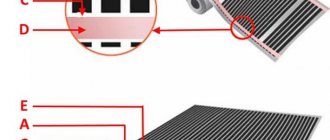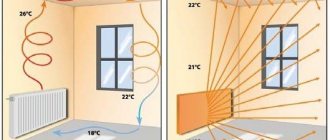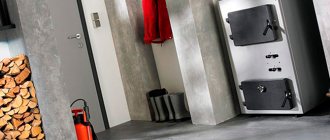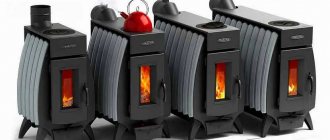Every modern inverter air conditioner can work not only for cooling, but also for heating.
It turns out that this device, in theory, can be used all year round, and not just during the summer heat.
True, there are people who still don’t believe in this, and you can easily find similar comments on the Internet.
By installing a good air conditioner as the main source of heating, you get rid of the problems with setting up and operating a gas or solid fuel boiler.
Radiators and heating pipes disappear from the rooms. There is no need to rack your brains about how best to lay out the system. Which pipes should be used to extend the supply and return lines from the boiler room in order to minimize losses.
How to adjust the temperature in the circuits. And many many others.
With an air conditioner, everything is simple and clear. Choose an installation location, pay 10-15 thousand for installation, or do it yourself, turn it on and use it.
However, do not forget that in fact, in this way you are switching to heating with electricity. All air conditioners are connected from an outlet.
And here a natural question arises: how profitable is such heating? Won't it be unprofitable compared to the same heaters or convectors?
To understand this, let's understand all the technical features and nuances.
Energy efficiency at home
Russian YouTube is full of videos about air-source heat pumps on air conditioners, and for some reason there is a clear tendency everywhere that if someone scolds them, they will definitely miss the advantages of the device and inflate the disadvantages, and vice versa.
This article will touch on both the positive and negative aspects of the issue.
Before you consider heating with air conditioning, check the insulation and energy efficiency of your home.
If it is useless, then no matter how powerful the unit you install, you will not stay warm in winter. And the type of heating has nothing to do with it.
It’s not for nothing that they say that the best heating is insulation! When everything is in order with this, you can start choosing an air conditioner.
Heating with a split system in winter - reviews from real people
We have collected reviews from real people about heating with split systems. All of them are based on personal experience and characterize the real state of affairs.
Stepan Akhmetovich, Ufa
I purchased a split system 2 years ago and made the right choice. At first I was sure that the store consultant was openly exaggerating when talking about the advantages of the air conditioner. But in practice it turned out that the seller was absolutely right. The room warms up perfectly. The temperature outside is sub-zero, but in my home it’s warm and cozy.
Sergey, Moscow
It's difficult to find any shortcomings. Perhaps the only downside is the price. But during operation, I still realized that the cost is quite justified. I wiped off dust several times a month, sometimes cleaned the internal parts, and that’s all the maintenance of the device is limited to. I am completely satisfied and would be happy to recommend this heating option to my friends.
Anna and Yuri, Kyiv
My husband and I recently had twins. A happy event, but also full of troubles. In particular, it was necessary to think about the warmth in the house. Adults can still tolerate some discomfort, but children are a different story. We debated the topic of heating for a long time and decided on a split system. The child grows up in an atmosphere of love, warmth and comfort. There are no complaints.
Yulia, Leningrad region
I live alone, and, to put it mildly, I don’t understand these heating systems. On the advice of my brother, I purchased and installed an air conditioner. In summer - pleasant freshness, no stuffiness. But in winter it’s not particularly happy. If the temperature drops below 0°C, the efficiency is not impressive. Still, there is some discomfort, and I am forced to use additional means to heat the room.
Ivan, Kazan
I’ve been thinking for a long time that my heating bills are too high. Moreover, the climate in the region is far from cool. Purely by chance I saw an advertisement for a modern split system. I don’t really trust these marketing ploys, but, as they say, he who doesn’t take risks, doesn’t drink champagne. My risk turned out to be completely justified. Profitable, functional, practical - an excellent option for residents of central Russia.
In the publication, we looked at heating with air conditioning, the disadvantages and advantages of this option. You can leave your reviews and opinions in the comments. Don't forget to share the post with your friends!
Do you want to get help from a master, a specialist in this field? Go to the professional search portal. This is a completely free service where you will find a professional who will solve your problem. You do not pay for posting an ad, views, or choosing a contractor. If you are a master of your craft, then register on Pro and receive a flow of clients. Your profit is just one click away!
How does air conditioning work for cold and heat?
First, let's remember how a regular device works. Here is its basic technological diagram.
Any air conditioner is like a heat pump. That is, it pumps thermal energy between two heat exchangers.
The principle of operation during cooling is as follows. The entire system is filled with a special liquid - freon.
The built-in compressor in the external unit compresses it, which causes the freon to heat up. Then, passing through the condenser, it is blown by air currents and cooled, turning into a liquid state.
Since the compressor still continues to pressurize the system, the freon moves on and reaches the expansion valve or flow regulator.
Simply put, the diameter of the main tube in this place increases sharply, which means a drop in pressure occurs. Losing pressure, freon goes into a gaseous state and, according to the laws of physics, cools sharply.
In this cold state, it enters the second heat exchanger or evaporator. Moreover, its temperature here is significantly lower than the ambient temperature.
As a result, freon takes excess heat from it and continues its march, returning back to the compressor. The cycle ends and everything repeats for the second round.
The operating principle of an air conditioner is heating, which is the reverse of cooling. At the same time, in modern devices there is no need to install anything additional.
When operating for heating, the air conditioner reduces the refrigerant to a temperature lower than “outside.” For example, if freon is cooled to -30C after passing through the expansion valve, then it will quite easily take heat from the surrounding air, even if it is -15C or -25C.
The whole difference will go towards heat transfer.
The main advantage of this scheme is that much less energy is spent on the operation of the compressor than on generating the corresponding amount of heat that the air conditioner is able to pump between two heat exchangers.
However, all conventional air conditioners, when operating on heat, have a maximum operating temperature. As a rule, it does not exceed -5C.
If you operate it at -10C and below, the air conditioner will go into the so-called zero efficiency mode.
The compressor will stop turning off altogether, will work at its maximum capacity and will eventually burn out.
To make it possible to warm up at lower temperatures, inverter models were invented.
Important information about temperature limits
For the cold season there are important restrictions. You cannot turn on the heating when the outside temperature is below 0 C°, otherwise the following problems will begin:
- the condensate on the external heat exchanger begins to freeze, so the outdoor unit begins to become covered with ice;
- as a result, heat transfer deteriorates;
- heating performance decreases.
At what temperature exactly can you turn on the air conditioner for cooling? It is important to ensure that it does not fall below +5 C°. If it is violated, the following may happen:
- the performance of climate control equipment will decrease;
- freezing will occur in the structure of the street block and drainage pipe;
- The compressor may break down during startup.
Air conditioner operating diagram
The difference between the operation of an inverter air conditioner
What is an inverter air conditioner and how does it differ from a simple one? The traditional device works according to a simple scheme: it heats the air to a certain temperature and immediately turns off the compressor. The so-called ON-OFF system.
That is, the compressor either works or doesn’t work at certain periods of time. But in inverter models it is possible not to completely turn off the compressor, but to reduce its rated power.
Why does this happen? Due to double conversion of electric current.
Initially, the standard alternating voltage from a 220V outlet is converted to direct voltage. And only then, with the help of an inverter, the direct current is again converted into alternating current, but not with the usual frequency of 50 Hz, but with an arbitrary one.
By adjusting and changing this very frequency, you can regulate the speed of the compressor rotor, and therefore change the power during operation.
You may ask, why all these troubles with frequency and power, and what exactly do they give? And they provide several advantages:
- absence of large starting currents when turned on
- less equipment wear
- but most importantly, a lower permissible operating temperature
That is, inverter models are able to start and operate at outside temperatures of -15C and below (-25C and even -30C). The oil in the system does not stagnate, but circulates constantly.
Most inexpensive household inverters certainly do not reach such low temperatures and operate normally between -5C and -7C.
If you installed such a household model at home, and the frost outside hit -25C, is it possible to turn it on or not? There are several options here.
Firstly, it may simply not start and go into defense. But if it does start working, its efficiency will drop significantly, as will the temperature in your house.
If such a low temperature remains for several days in a row, the oil in the device will thicken.
In this case, it is not recommended to turn off the air conditioner, otherwise a subsequent cold start will kill its compressor.
During operation, for better heating of the room, all inverter models must be able to direct the air flow vertically downwards. In this case, the room will warm up much faster. There is no particular point in heating the ceiling with warm air.
Because of this feature, some advise placing the indoor unit as low as possible, at a level of 0.5 m from the floor. True, in summer such cold for the feet will be very unpleasant.
So look for a compromise.
Possible problems
When your air conditioner is running for heating in the winter, it is at greater risk of breakdown than in the summer. Therefore, it is worth monitoring its work more carefully. If suddenly the air conditioner stops turning on for heating or produces less heat, you need to pay attention to this. Check the following:
Does the compressor run when the air conditioner is turned on? If not, try warming it up with a regular hair dryer. It may not turn on for the following reasons:
- Due to the low temperature, the oil became too viscous;
- There is an oil leak (check the bottom of the compressor for leaks);
- The compressor has failed.
Sometimes the air conditioner starts to work worse for heating. than usual. In this case, please note the following:
- Is the fan working? If not, warm up its bearing with a hairdryer. But it's better to replace it;
- The condenser radiator in the outdoor unit or the grille in front of the fan may have iced up. If so, melt the ice with hot water;
- Freon leak. It is impossible to determine such a problem on your own. If none of the above helped you, contact a specialist .
COP and air conditioner efficiency
However, the ability to operate at low negative temperatures is not the main thing. What else should you focus on when choosing an inverter air conditioner, so that its operation creates a sufficient amount of heat in the house and is profitable at the same time?
The COP (Coefficient of Performance) coefficient is responsible for this - the coefficient of efficiency or conversion. It can be found in the full list of characteristics.
COP is the ratio of the thermal performance of an air conditioner in heating mode to its electrical power, that is, how much electricity it consumes from the outlet.
What COP value is considered good? For the best models it reaches 5 units. From 3.5 to 4.0 these are average parameters.
For example, cop=3.61 means that with a power of 1 kW, such an inverter is capable of pumping a thermal power of 3.61 kW into the room in 1 hour.
A similar parameter when working for cooling is called coefficient. EER. It shows how much thermal power is pumped out of the room in accordance with the consumed electrical power of the air conditioner.
The higher the COP, the more profitable and expensive the air conditioner. As mentioned above, a good value is COP=5.0. Having such a device, having spent one kilowatt of electric energy in 1 hour, you will drive 5 kW of heat into your room.
How profitable is this? At current prices for electricity, 1 kW of heat when heating with such an air conditioner in Moscow or the region will cost you about 1 ruble.
In some regions, costs will be one and a half times less. It seems that it is even cheaper than heating with wood, not to mention heating with other electrical appliances.
But this is where the main trick lies. The OPC parameter specified in the technical documentation was measured under some ideal conditions. Specifically, when working for heating with an ambient temperature of +7C.
As the outside temperature decreases, the COP will decrease, just as it does when the room temperature increases. If the best Japanese inverters have a COP of 5.0 at outdoor temperature t=+7C and room temperature +20C, and you want to heat up the room to +30C without changing the outdoor parameters, COP will immediately drop to 4.0-4.5.
And if it gets colder outside, this parameter will drop much more. In frosts of -25C, branded “Japs” have a COP within the range of 1.5-2.0. That is, the efficiency drops by half.
So what, you say. It’s still more profitable and 2 times cheaper than heating with oil batteries or a convector. Actually not quite like that.
Feasibility of the process
Air conditioners with heating function are structurally different from their older counterparts. The devices are equipped with a heat pump, making them very economical: one kilowatt of electricity spent on the air conditioner produces 2.5 to 4.2 kW of heat at the output. The devices are capable of efficiently heating a room at outside temperatures from 0 to -15 degrees, but more powerful units can easily cope with frosts of 30 degrees. For comparison: an oil heater, consuming the same kilowatt of electricity, is capable of delivering only 0.95 kilowatts of heat.
It follows from this that heating costs using an air conditioner are spent two times less than heating a house with a heater. However, it is advisable to choose an air conditioner as a heat source only in non-gasified regions, or in places where expensive liquefied propane is used instead of natural gas. In other cases, heating with air conditioning is certainly more expensive than heating with natural gas, and preference should be given to the latter.
When is air conditioning beneficial?
As mentioned above, manufacturers indicate “cop” under ideal conditions. They are “modestly” silent about the energy consumption for defrosting or defrosting cycles, the number and duration of which increases at -15C and below.
Add here the extra kilowatts for heating the sump and compressor crankcase. What's left in the end?
And as a result, at temperatures from -15C, even with a relatively modern inverter, you will save energy in the region of 10-20% compared to conventional heaters.
If the COP was initially low (domestic model), then you will not receive any benefit at all. It's the same as buying a 2-kilowatt heat blower and running it under the ceiling.
Therefore, look at the average annual winter temperature in your region and in the presence of prolonged cold weather, buy air conditioners with a COP efficiency rating of 4 or higher.
Only in this case will heating with air conditioners be more profitable than heating the room with direct heating devices.
To understand the effectiveness of a particular model, you need to compare their COP graphs depending on the ambient temperature.
How much will you have to pay?
The heating split system itself costs from 50,000 rubles. plus installation. Although this work in private homes can be done independently. However, this is only the case when you have not only the right tool, but also the knowledge. It may seem that heating a room with a heat pump costs the same as using a breeze or any other household heater. But actually it is not. Home heaters use energy to heat the coil and operate the fan. A split system, on the other hand, takes heat from the air and spends energy only on the fan and heating the working elements to prevent ice. As a result, according to manufacturers, the efficiency of heat pumps is approximately 3-5 kW of heat per 1 kW of expended electricity, while for a conventional heater 1 kW of expended energy is equal to 1 kW of heat. These calculations are, of course, very arbitrary. Much depends on the heater model, the energy efficiency of the room, weather conditions, etc. But nevertheless, a conclusion can be drawn. You can install the air conditioner yourself. The main thing is to follow the manufacturers' instructions. As a result, if you do not have the opportunity to heat your house using a gas boiler or you do not want to constantly be dependent on the supply of fuel to solid fuel boilers, of all the remaining heating options using electricity, using a heat pump may be the most cost-effective .
Comparison of air conditioners when operating for heating
Below are independent results of research and measurements of this coefficient (taking into account defrosting cycles!), which were carried out with some of the highest quality brands of air source heat pumps - Mitsubishi Electric, Panasonic, Gree, Fujitsu. To view, click on the appropriate tab.
Mitsubishi ElectricPanasonic CS-NE9MKEPanasonic CS-HE9LKEGreeMitsubishi HeavyFujitsu
Mitsubishi Electric MSZ-FH25VE + Mitsubishi Electric MUZ-FH25VEHZ
Panasonic CS-NE9MKE + CU-NE9MKE
Panasonic CS-HE9LKE + CU-HE9LKE
Gree Hansol 25-A (GWH09TB-S3DNA2D/I) + GWHT09TB-S3DNA1D/O
Mitsubishi Heavy Industries SRK25ZJX + SRK25ZJX-SA
Fujitsu ASYG09LMCB + AOYG09LMCBN
The market leader is Mitsubishi Zubadan. However, you should not believe the marketing and purchase budget models of this brand. They are distinguished from conventional splits mainly by a more powerful compressor. You are unlikely to get normal heating at -25C from them either.
The energy efficiency of real Zubadans, depending on the region of your residence and the average temperature in winter, can be calculated on a convenient online calculator on the Mitsubishi website here.
Based on the above tables, you can make your choice. Complete data on the most popular and effective brands with test reports are available via the link here (site in Finnish, use Google translator).
If COP is not initially indicated anywhere on the device, you can calculate it yourself. To do this, divide the thermal power, which is written on the device nameplate, by the consumed electrical power.
How to choose the power of the air conditioner according to the area of the room, read a separate article.
Switching the air conditioner to heat
How to properly switch the air conditioner to heat? First, make sure that it is actually designed to operate in sub-zero temperatures. Check the documentation for the maximum degrees.
Switching from cooling mode to heating mode is carried out using the remote control.
In the menu or on the buttons, select the Heat mode, or the key with the sun icon.
Please note that in some remote controls, until you remove the batteries and insert them back, the “sun” icon will not appear on your screen. This is the so-called child protection so that they do not accidentally switch the air conditioner to heat in the summer.
Remember, warm air does not start flowing immediately, but after 5-10 minutes.
Possible breakdowns
Every user should know that it is necessary to use a split system for heating according to the instructions. The main reasons for frequent breakdowns are improper use of the device and non-compliance with temperature conditions. Situations often arise when, after pressing the necessary buttons and selecting the desired mode, the heat does not flow. There can be many reasons for this and they definitely need to be checked. The following phenomena are not uncommon:
- The batteries in the control panel do not work;
- the sensor does not respond well to the device;
- there are violations in the operation of software;
- severe damage to the air conditioner.
The most common cause of device failure is a malfunction of the batteries in the remote control, so many people think that they were given a defective device. Solving the problem is very simple, just change them for new ones and start the device again.
If the problem lies in a sensor malfunction, then in this case you will not be able to solve it yourself. It is best to return the device under warranty or call a repairman. If the air conditioner's warranty is still valid, then the air conditioner must be replaced with a new one or the sensor equipment must be replaced.
Software glitches are not uncommon. They always manifest themselves in different ways. The system may freeze, the air conditioner may reboot on its own, turn on and off.
All this makes it clear that there are problems that urgently need to be solved before the device breaks down completely. Therefore, it is better not to try to repair the device yourself, but to contact a service center.
When the equipment completely stops working, if it was used for other purposes or was frequently rebooted, repairs for such problems will be expensive, and it is better to think about buying a new air conditioner.
Features of operation in winter
In winter, the air conditioner defrosts at certain intervals. This usually happens once every 40-60 minutes.
When working for a long time at subzero temperatures, its radiator freezes over, efficiency drops, and the system begins to deal with it on its own.
Many people mistakenly believe that the external unit in this case is heated by some kind of built-in heating elements. This is wrong.
It simply switches the direction of its work. That is, hot freon from the indoor unit begins to flow into the outdoor unit. And it thaws within a few minutes.
The duration and frequency of defrost cycles depends on the degree of icing and is controlled by sensors. Although in inexpensive options this happens simply according to the programmed time.
Main purpose of the device
The main function of an air conditioner is to cool the room temperature during the hot season, which is why many people go to a hardware store before the start of the summer season. Split systems are equipped with copper cooling pipes that use freon. The indoor module has a heat exchanger through which it evaporates and releases cold air into the room. Near him there is a propeller that drives him back and forth.
Then the heated freon enters the outdoor unit and begins to transform inside it, i.e., it gives off heat and begins to evaporate again and produce cold, which is why almost all split systems have 1 mode - “cooling”.
Defrosting the air conditioner and heating the pan
The water that thaws from the radiator grilles flows into the pan and ice begins to accumulate there. If it is not removed, it bends and deforms the heat exchanger tubes. Here are the clear consequences of such freezing.
Sometimes he even gets to the fan. To prevent this from happening, choose models with a heating cable built into the tray.
If you don’t have one, you’ll have to remove the lid of the device each time and use a hot kettle to pour over the frozen areas. You can’t knock anything down manually, otherwise in the cold you’ll only make it worse.
A heating cable built into the tray is an extra expense of electricity, which manufacturers are silent about. It turns on based on the temperature sensor and will generate kilowatts, even if the air conditioner is not working, but is simply plugged into the outlet.
About 2 kW can run per day.
In the tray of non-sophisticated models, you can build your own cable, bringing out the wires for connection in a separate circuit. Attach a plug to the end of the cable and turn it on through the timer socket.
In order to determine the optimal operating time, observe the air conditioner for several days and record the moments when ice forms.
Please note that if you have a new condo, you cannot drill any holes for cable fastening or additional water drainage, otherwise you will lose your warranty. Craftsmen use neodymium magnets to secure the cable.
A similar cable is used for roof heating or for heated floors outdoors.
In addition to the pallet, a couple or three turns of such wire are made around the compressor. In cold weather, this prevents the oil from thickening and makes it easier to start the device.
However, if your split system is not initially designed to operate in winter, such a home-made winter kit will not help, and even harm!
In these devices, the compressor has a slightly different winding configuration. In addition, the valves in them are designed for different condensation/boiling pressure modes.
You will also need an electronic expansion valve to keep the freon overheating on the evaporator to a minimum, and therefore work as efficiently as possible under any thermal conditions from -30C to +15C. Without all this, you will ruin your device.
One thing should not be confused with all this heating - factory winter kits for air conditioners are designed to work in winter for cooling!
When working with heat, you only need to warm up two things:
- compressor crankcase
- pallet
During the defrosting process, ice will accumulate under the air conditioner.
It would be good if it was in the form of a stalactite. He knocked it down with a crowbar and threw it aside. But most often it spreads over a large area, causing heaving of the soil and even movement of the foundation.
How to deal with this? Place a deep rubber tray under the air conditioner. All you have to do is periodically pull it out and shake it free of ice.
Installation rules
You should not think that the air conditioner will be able to work effectively if mistakes were made during its installation. This is a rather complex unit, the installation of which should be approached with maximum responsibility. Most often, problems with the operation of the device arise due to improper organization of air circulation. It should be remembered that air must not only flow freely into the unit, but also be removed from it.
To ensure that the installation of an air conditioner is successful, you should listen to several recommendations:
- using brackets or anchors, the external unit must be mounted at a certain distance from the wall;
- to install the unit in a horizontal plane, use a building level;
- It is advisable to install a separate circuit breaker for the unit in the distribution panel;
- to prevent condensation from collecting inside the system, the drainage pipe should be mounted at an angle;
- the height difference between the external and internal units should not exceed 20 m;
- Do not install the indoor unit above heating radiators or other heat sources.
Installing a split system is a rather complicated process, so this work should be entrusted to professionals. However, any user will be able to independently change the operating modes of the unit. To do everything correctly, most often it is enough to simply carefully study the operating instructions.
Winter maintenance
How should an inverter air conditioner operating for heating be maintained? Apart from ice removal, maintenance is no different from any other air conditioner.
If you do not want to breed mold and mildew, it is enough to clean its filter once every two weeks and wash the impeller twice a year after disassembling the device. All bacteria and fungi that are dangerous to health also accumulate there.
Other types of work, for example, topping up freon or inspecting the external unit, should be carried out by specialists with the appropriate equipment. You better not go there.
Let's sum it up
In this publication, we examined the question at what temperature you can turn on the air conditioner for heating in winter. Let's summarize the above:
- Check the minimum operating temperature in the instructions for your model;
- The average minimum temperature of inverter air conditioners is: -30...-20 °C, conventional: -5...+5 °C;
- The compressor of a conventional air conditioner wears out faster in cold weather than that of an inverter;
- It is better to start the air conditioner at a temperature higher than the minimum by 2-5 degrees;
- The colder it is “outside”, the worse the air conditioner heats;
- Warm up the air conditioning compressor for 2-3 minutes with minimal load;
- If you don’t want problems, install a winter kit.
Sources
- https://vozduhstroy.ru/kondicionery/pri-kakoj-temperature-mozhno-vklyuchat-na-obogrev.html
- https://hitech-online.ru/klimaticheskaya/konditsioner/pri-kakoj-temperature-mojno-vklyuchat.html
- https://domikelectrica.ru/otoplenie-doma-kondicionerom/
- https://TopVentilyaciya.ru/konditsionirovanie/mozhno-li-vklyuchat-konditsioner-zimoj.html
- https://morrozko.ru/ispolzovanie-konditsionera-zimoy-na-obogrev/
- https://dantex.ru/articles/mozhno-li-vklyuchat-konditsioner-zimoy-obogrev-i-okhlazhdenie-pri-nizkikh-temperaturakh/
- https://tehnika.expert/klimaticheskaya/kondicioner/pri-kakoj-temperature-mozhno-vklyuchat.html
- https://sovet-ingenera.com/vent/cond/mozhno-li-ispolzovat-konditsioner-dlya-obogreva-pri-moroze.html
- https://StrojDvor.ru/kondicionirovanie/mozhno-li-ustanavlivat-i-ispolzovat-kondicionery-zimoj/
- https://tehnofaq.ru/rabota-konditsionera-zimoj/
- https://VTeple.xyz/pri-kakoj-temperature-mozhno-vkljuchat-kondicioner-na-obogrev/
[collapse]
